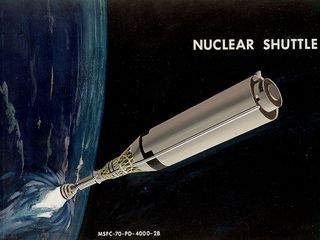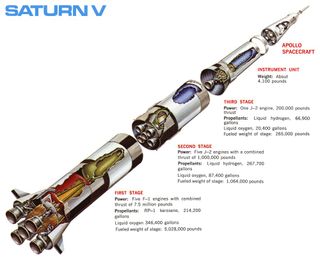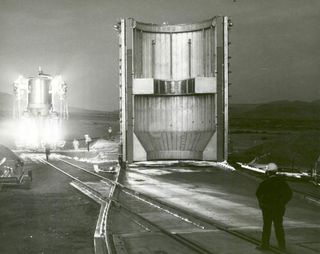
This article was originally published at The Conversation. The publication contributed the article to Space.com's Expert Voices: Op-Ed & Insights. Read the original article.
Iain Boyd, Professor of Aerospace Engineering Sciences, University of Colorado Boulder
With dreams of Mars on the minds of both NASA and Elon Musk, long-distance crewed missions through space are coming. But you might be surprised to learn that modern rockets don't go all that much faster than the rockets of the past.
There are a lot of reasons that a faster spaceship is a better one, and nuclear-powered rockets are a way to do this. They offer many benefits over traditional fuel-burning rockets or modern solar-powered electric rockets, but there have been only eight U.S. space launches carrying nuclear reactors in the last 40 years.
However, last year the laws regulating nuclear space flights changed and work has already begun on this next generation of rockets.
Why the need for speed?
The first step of a space journey involves the use of launch rockets to get a ship into orbit. These are the large fuel-burning engines people imagine when they think of rocket launches and are not likely to go away in the foreseeable future due to the constraints of gravity.
It is once a ship reaches space that things get interesting. To escape Earth's gravity and reach deep space destinations, ships need additional acceleration. This is where nuclear systems come into play. If astronauts want to explore anything farther than the moon and perhaps Mars, they are going to need to be going very very fast. Space is massive, and everything is far away.
Get the Space.com Newsletter
Breaking space news, the latest updates on rocket launches, skywatching events and more!
There are two reasons faster rockets are better for long-distance space travel: safety and time.
Astronauts on a trip to Mars would be exposed to very high levels of radiation which can cause serious long-term health problems such as cancer and sterility. Radiation shielding can help, but it is extremely heavy, and the longer the mission, the more shielding is needed. A better way to reduce radiation exposure is to simply get where you are going quicker.
But human safety isn't the only benefit. As space agencies probe farther out into space, it is important to get data from uncrewed missions as soon as possible. It took Voyager 2 12 years just to reach Neptune, where it snapped some incredible photos as it flew by. If Voyager 2 had a faster propulsion system, astronomers could have had those photos and the information they contained years earlier.
Speed is good. But why are nuclear systems faster?

Systems of today
Once a ship has escaped Earth’s gravity, there are three important aspects to consider when comparing any propulsion system:
- Thrust – how fast a system can accelerate a ship
- Mass efficiency – how much thrust a system can produce for a given amount of fuel
- Energy density – how much energy a given amount of fuel can produce
Today, the most common propulsion systems in use are chemical propulsion — that is, regular fuel-burning rockets — and solar-powered electric propulsion systems.
Chemical propulsion systems provide a lot of thrust, but chemical rockets aren't particularly efficient, and rocket fuel isn't that energy-dense. The Saturn V rocket that took astronauts to the Moon produced 35 million Newtons of force at liftoff and carried 950,000 gallons of fuel. While most of the fuel was used in getting the rocket into orbit, the limitations are apparent: It takes a lot of heavy fuel to get anywhere.
Electric propulsion systems generate thrust using electricity produced from solar panels. The most common way to do this is to use an electrical field to accelerate ions, such as in the Hall thruster. These devices are commonly used to power satellites and can have more than five times higher mass efficiency than chemical systems. But they produce much less thrust — about three Newtons, or only enough to accelerate a car from 0-60 mph in about two and a half hours. The energy source — the sun — is essentially infinite but becomes less useful the farther away from the sun the ship gets.
One of the reasons nuclear-powered rockets are promising is because they offer incredible energy density. The uranium fuel used in nuclear reactors has an energy density that is 4 million times higher than hydrazine, a typical chemical rocket propellant. It is much easier to get a small amount of uranium to space than hundreds of thousands of gallons of fuel.
So what about thrust and mass efficiency?

Two options for nuclear
Engineers have designed two main types of nuclear systems for space travel.
The first is called nuclear thermal propulsion. These systems are very powerful and moderately efficient. They use a small nuclear fission reactor — similar to those found in nuclear submarines — to heat a gas, such as hydrogen, and that gas is then accelerated through a rocket nozzle to provide thrust. Engineers from NASA estimate that a mission to Mars powered by nuclear thermal propulsion would be 20%-25% shorter than a trip on a chemical-powered rocket.
Nuclear thermal propulsion systems are more than twice as efficient as chemical propulsion systems — meaning they generate twice as much thrust using the same amount of propellant mass — and can deliver 100,000 Newtons of thrust. That’s enough force to get a car from 0-60 mph in about a quarter of a second.
The second nuclear-based rocket system is called nuclear electric propulsion. No nuclear electric systems have been built yet, but the idea is to use a high-power fission reactor to generate electricity that would then power an electrical propulsion system like a Hall thruster. This would be very efficient, about three times better than a nuclear thermal propulsion system. Since the nuclear reactor could create a lot of power, many individual electric thrusters could be operated simultaneously to generate a good amount of thrust.
Nuclear electric systems would be the best choice for extremely long-range missions because they don't require solar energy, have very high efficiency and can give relatively high thrust. But while nuclear electric rockets are extremely promising, there are still a lot of technical problems to solve before they are put into use.
Why aren't there nuclear-powered rockets yet?
Nuclear thermal propulsion systems have been studied since the 1960s but have not yet flown in space.
Regulations first imposed in the U.S. in the 1970s essentially required case-by-case examination and approval of any nuclear space project from multiple government agencies and explicit approval from the president. Along with a lack of funding for nuclear rocket system research, this environment prevented further improvement of nuclear reactors for use in space.
That all changed when the Trump administration issued a presidential memorandum in August 2019. While upholding the need to keep nuclear launches as safe as possible, the new directive allows for nuclear missions with lower amounts of nuclear material to skip the multi-agency approval process. Only the sponsoring agency, like NASA, for example, needs to certify that the mission meets safety recommendations. Larger nuclear missions would go through the same process as before.
Along with this revision of regulations, NASA received $100 million in the 2019 budget to develop nuclear thermal propulsion. DARPA is also developing a space nuclear thermal propulsion system to enable national security operations beyond Earth orbit.
After 60 years of stagnation, it’s possible a nuclear-powered rocket will be heading to space within a decade. This exciting achievement will usher in a new era of space exploration. People will go to Mars and science experiments will make new discoveries all across our solar system and beyond.
This article is republished from The Conversation under a Creative Commons license. The views expressed are those of the author and do not necessarily reflect the views of the publisher.
Join our Space Forums to keep talking space on the latest missions, night sky and more! And if you have a news tip, correction or comment, let us know at: community@space.com.

Iain D. Boyd is the H.T. Sears Memorial Professor in the Department of Aerospace Engineering Sciences, and Director of the Center for National Security Initiatives at the University of Colorado. He received a Ph. D. in aeronautics and astronautics (1988) from the University of Southampton in England. He worked for four years at NASA Ames Research Center in the areas of aerothermodynamics and space propulsion. Dr. Boyd was a faculty member in mechanical and aerospace engineering at Cornell University for six years. He joined the University of Michigan in 1999 and worked there for 20 years. His research interests involve the development and application of physical models and computational methods for analysis of nonequilibrium gas and plasma dynamics processes in aerospace systems.
-
SDelMonte As long as there is a fear of a rocket launch that has any risk of radioactive debris falling on the ground, no one will stand for nuclear rockets.Reply -
Helio It would seem more likely that some sort of fusion system would be the far better idea. Several kilograms of hydrogen could be scooped from the space travelled to minimize their hull impact and be used as fuel. Some of the helium produced could be used for the children's balloons as well. :)Reply -
DrRaviSharma Response to Comment 1Reply
If we design aerodynamic shape of reentry of Nuclear Power reactor then less chance that it would break as Radioisotope Thermal Generator on Apollo 13 Lunar module did enter safely and fell in Mariana Trench off east of Japan or south. -
DrRaviSharma Response to Comment 2Reply
Yes excellent idea, we have toget them working on earth then space.
If our congress had not adhoc terminated Tokomac and other related Fusion research 50 years ago, we would be in great shape today and not lose as we are losing in lot of other important areas where we have leadership. -
geoffrey.landis A desirable feature of nuclear reactors is that they are not radioactive until you start the chain reaction by turning them on. A launch accident wouldn't spread radioactive debris, because the reactor would be launched cold.Reply -
DrRaviSharma Today we have better optionsReply
Wait for fusion to mature for rocket engines
Robotic assembly of fission reactor and making it critical remotely in space
Better shielding
Ion engine alternatives to chemical fuel
We had NERVA and other nuclear rocket programs at NASA during 1968-72 when I participated in Human Space Flight Program and also received NASA Apollo Achievement Award. -
Amelia Ashford Orion Project has been existed for quite sometime...Reply
However, public fears of nuclear radioactive did halted it... which is, i think the biggest problem when it comes to anything to do with the word "Nuclear"/N-word
Heck even there is still to this days, people that fears of nuclear energy reactor... -
Truthseeker007 Thought this was interesting:Reply
In the Sanskrit Samarangana Sutradhara (Literally, "controller of the battlefield"), it is written:
"Strong and durable must the body of the Vimana be made, like a great flying bird of light material. Inside one must put the mercury engine with its iron heating apparatus underneath. By means of the power latent in the mercury which sets the driving whirlwind in motion, a man sitting inside may travel a great distance in the sky. The movements of the Vimana are such that it can vertically ascend, vertically descend, move slanting forwards and backwards. With the help of the machines human beings can fly in the air and heavenly beings can come down to earth."https://www.crystalinks.com/vimanas.html -
newtons_laws Reply
Yeah but nobody is seriously suggesting using the Orion Project approach (letting off a series of miniature explosions against a "pusher plate" on the base of the vehicle to launch it from the ground through the atmosphere into Space), the resultant level of radioactive fallout would (rightly) prevent it being used. The Nuclear Thermal Propulsion approach being advocated would use a Uranium fuelled reactor which is only switched on once it has been been successfully launched by a conventional chemical rocket into Space.Amelia Ashford said:Orion Project has been existed for quite sometime...
However, public fears of nuclear radioactive did halted it... which is, i think the biggest problem when it comes to anything to do with the word "Nuclear"/N-word
Heck even there is still to this days, people that fears of nuclear energy reactor...
And as regards the first comment on this thread from SDelMonte "As long as there is a fear of a rocket launch that has any risk of radioactive debris falling on the ground, no one will stand for nuclear rockets. " I don't know if the objectors realise that the Uranium fuel in a reactor which hasn't yet been switched on has negligible radioactivity (you can hold an unused Uranium fuel element safely in your hands), much less than that of the Plutonium 238 Radioisotope Thermal Generators on board numerous robotic spacecraft that have been safely launched and most people accept those. :) -
FrankT Assuming the video clips of UFO declassified by Pentagon were real. Those clips have shed some light into the future of transport to mankind. The "Tic Tac" shaped transport vehicles were flying with instantaneous acceleration and deceleration. They could make 90 degree turn instantaneously. They could fly at a speed of 28,000 ft in 0.7 seconds, with neither hot spots nor emission detected. Their motions broke all Newton's law of motions. One speculation is, they are not governed by Gravity. Imagine a moving body that does not interact with Higgs Field. A moving body that does not have mass in the space it is travelling. If a vehicle can become "massless", it does not have to obey Newton's law, it can go at superluminal speed. Those 'Tic Tac' shaped transport vehicles has provided a glimpse into the far future of our technology, which we may or may never comprehend one day.Reply
